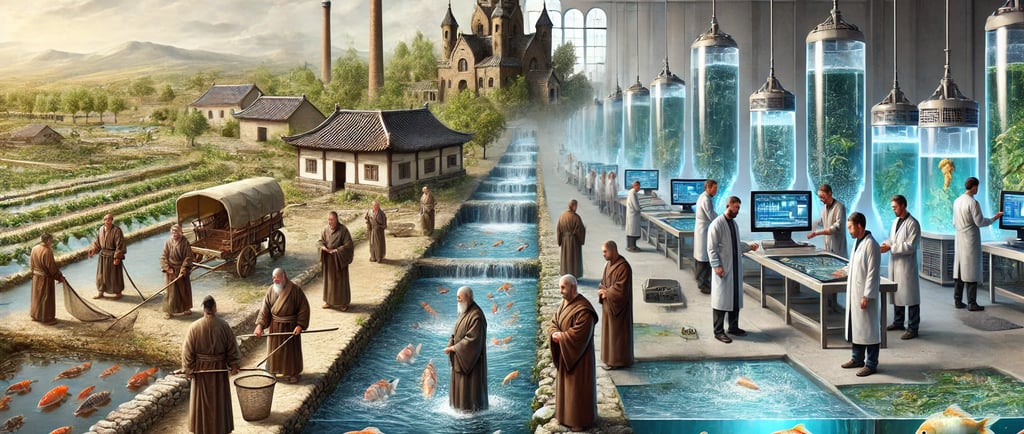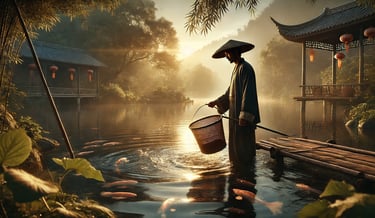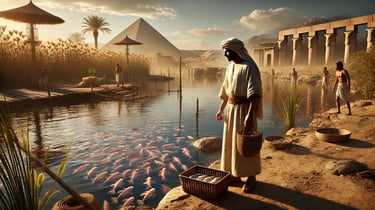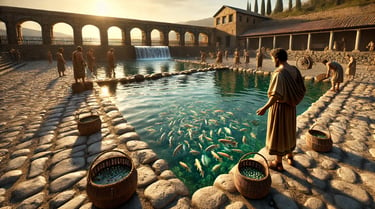The Evolution of Fish Farming: From Ancient Practices to Modern Techniques
The history of fish farming showcases its journey from ancient techniques like Chinese carp ponds to modern innovations like Recirculating Aquaculture Systems (RAS). Over time, fish farming has evolved into a sustainable practice that addresses global food demands while reducing environmental impact through advanced technology and sustainable methods.


The Evolution of Fish Farming: From Ancient Practices to Modern Techniques
Introduction
Fish farming, also known as aquaculture, has played a crucial role in human civilization for thousands of years. This practice, which involves the controlled breeding, rearing, and harvesting of fish and other aquatic organisms, has evolved significantly from simple traditional methods to advanced, technology-driven systems. Over the centuries, human innovation has improved the sustainability, efficiency, and productivity of fish farming. This blog delves into the history of fish farming, tracing its evolution from ancient times to modern practices, while highlighting major milestones, technological advancements, and the methods that define contemporary aquaculture.
Ancient Practices of Fish Farming
1. Early Aquaculture in China (2000 BCE)
The origins of fish farming can be traced back to ancient China around 2000 BCE. The Chinese were among the first to recognize the potential of controlled fish cultivation. The domestication of common carp (Cyprinus carpio) is one of the earliest examples of aquaculture. Fish ponds were built to rear carp, and farmers developed selective breeding methods to produce carp with desirable traits, such as faster growth and resistance to disease. The legendary Chinese book "The Classic of Fish Culture" written by Fan Li around 500 BCE, remains one of the earliest records documenting aquaculture practices.
2. Aquaculture in Ancient Egypt (1500 BCE)
Egypt also played a pivotal role in early aquaculture. Archaeological evidence indicates that the ancient Egyptians used man-made ponds along the Nile River to rear fish. These ponds protected fish from predators and allowed for more controlled harvesting. Fish such as tilapia were integral to the Egyptian diet and were depicted in ancient artwork and hieroglyphics. The Nile River, being a lifeline for Egypt’s civilization, provided an ideal environment for fish farming to flourish.
3. Fish Farming in the Roman Empire (500 BCE)
The Romans advanced aquaculture through innovations in fish farming infrastructure. They built "vivaria," which were fish ponds connected to natural water bodies. The Romans also cultivated oysters and other shellfish in Mediterranean lagoons. These farming systems allowed fish to be kept alive and fresh until they were ready to be consumed. Roman fish farming was sophisticated, utilizing natural tidal flows to maintain fresh water in the ponds. This system greatly influenced aquaculture techniques in Europe.
Medieval Innovations
1. Monastic Fish Ponds in Europe (Middle Ages)
During the Middle Ages, monastic communities in Europe became pioneers in aquaculture. Monks maintained fish ponds as a sustainable source of protein, especially during religious fasting periods when meat consumption was restricted. These fish ponds were integrated into monastery grounds and operated as closed ecosystems where water from nearby rivers was diverted to fill the ponds. Carp remained the primary fish species grown in these ponds, and the practice laid the foundation for modern European aquaculture.
2. Technological Improvements in the Renaissance
As Europe entered the Renaissance period, aquaculture practices became more sophisticated. Knowledge of water quality, fish nutrition, and controlled breeding grew. Landowners and aristocrats began constructing fish ponds for commercial purposes. These developments contributed to more systematic aquaculture practices, where water flow, pond depth, and fish stocking densities were regulated.
The Modernization of Fish Farming
1. Industrial Revolution and Technological Advancements (19th Century)
The Industrial Revolution marked a significant shift in fish farming. Mechanization and technological advancements played a critical role in improving efficiency and production. The use of artificial feeds, aeration systems, and fish hatcheries became more widespread. Hatcheries allowed for the mass production of fish larvae and juveniles, enabling larger-scale fish farming. Farmers also began to focus on selective breeding to develop fish strains with faster growth rates and resistance to diseases.
2. The Introduction of Controlled Hatcheries
Controlled hatcheries emerged as a key innovation in the late 19th century. Fish hatcheries allowed farmers to control every stage of fish production, from spawning to the release of juvenile fish. The ability to breed fish in controlled conditions increased the availability of fingerlings, which could then be used to stock fish ponds, lakes, and rivers. This development laid the groundwork for commercial aquaculture on a large scale.
3. Aquaculture Becomes a Global Industry (20th Century)
The 20th century saw the growth of aquaculture as a global industry. Governments and private enterprises began to support fish farming as a means to address food security and reduce fishing pressure on wild fish stocks. New species, such as Atlantic salmon, trout, and shrimp, were introduced to fish farming. Advances in water quality monitoring, oxygenation systems, and disease management further improved aquaculture efficiency. Countries like Norway, Japan, and the United States became leaders in modern aquaculture production.
Modern Techniques in Fish Farming
1. Recirculating Aquaculture Systems (RAS)
Recirculating Aquaculture Systems (RAS) are advanced land-based systems where water is continuously filtered and reused. These systems allow for precise control of water quality, temperature, and oxygen levels. RAS is widely used to farm high-value species like salmon, trout, and tilapia. The closed-loop nature of RAS reduces water consumption and minimizes waste discharge, making it an environmentally friendly option.
2. Cage Farming
Cage farming involves raising fish in large cages or net enclosures placed in natural water bodies such as lakes, rivers, and oceans. The cages are anchored to the seabed, and water flows freely through them, providing fish with natural water conditions. Cage farming is commonly used for species such as salmon, sea bass, and tilapia. However, it requires careful management to prevent disease outbreaks and environmental impacts.
3. Integrated Multi-Trophic Aquaculture (IMTA)
IMTA is a sustainable approach to aquaculture that integrates multiple species within a single farming system. For example, fish, shellfish, and seaweed are farmed together, with each species contributing to environmental balance. Waste from fish becomes nutrients for shellfish and seaweed, creating a natural, circular system. IMTA improves resource efficiency and biodiversity.
4. Biofloc Technology
Biofloc technology is a recent innovation that promotes the growth of beneficial microorganisms in fish farming water. These microorganisms convert fish waste and excess feed into a protein-rich biomass, which the fish can then consume. This process reduces feed costs and improves water quality. Biofloc is widely used in shrimp and tilapia farming and supports sustainability by recycling nutrients.
5. Aquaponics
Aquaponics combines aquaculture with hydroponics, allowing fish and plants to grow together in a closed system. Fish waste provides nutrients for plants, and plants purify the water, which is recirculated to the fish. This method allows farmers to produce both fish and vegetables in the same system, maximizing resource efficiency.
Challenges and Future Prospects
1. Disease Management
One of the significant challenges in aquaculture is managing fish diseases. Intensive farming environments increase the risk of disease outbreaks. Vaccines, probiotics, and biosecurity measures are used to prevent and control disease.
2. Environmental Concerns
Fish farming can impact the environment if not managed properly. Excessive feed use, waste discharge, and the risk of escaped farmed fish interbreeding with wild fish are common concerns. To mitigate these impacts, sustainable practices such as RAS and IMTA are being promoted.
3. Climate Change Implications
Climate change affects water temperature, oxygen levels, and the frequency of disease outbreaks. Fish farms must adapt to changing environmental conditions to maintain productivity. Innovations in closed systems like RAS offer a solution to climate-related challenges.
4. Technological Innovations
The future of fish farming will rely on smart technologies, including sensors, Internet of Things (IoT) devices, and artificial intelligence (AI). Smart systems can monitor water quality in real time, detect disease outbreaks early, and optimize feeding schedules, thereby improving productivity and efficiency.
Conclusion
The evolution of fish farming from ancient practices to modern techniques is a testament to human ingenuity and adaptation. From the carp ponds of ancient China to the high-tech RAS and biofloc systems of today, fish farming has become a crucial component of the global food supply. As demand for seafood continues to rise, the adoption of sustainable and environmentally friendly practices will be essential. Through technological innovation, aquaculture will continue to evolve, ensuring a steady supply of nutritious fish to feed the world’s growing population.






